Does running a preamp with no heater voltage to the 2nd output tube damage anything in the preamp?
Old thread on this is closed and my situation is diff. I have a Pilot 505 Amp. Recently dug the tuner/preamp out of storage and found someone had recapped it. Plugged it in and it sounded great using my Andover Spin Stage as a phono preamp. Then discovered that two tubes were not heating up---the end tube in the preamp (the preamp uses a 12AX7 then a 12AU7, the AU socket was dead) and one of the sockets in the phonograph preamp portion. Note that I played this most of the afternoon with a friend and it sounded really good.
When I discovered that two sockets were dead, I found that the heaters for those sockets were powered by the 2nd power socket, which dummy me had not plugged in. Also turned out the tube that we thought produced the cleanest sound was dead. The unit had output, possibly due to how a feedback is wired, but working none-the-less. Perhaps, since the grid and cathode were in a live circuit, the unit sounded better with a dead tube in that position? Now, fully functional, the volume is higher (CDs have to be played in the 1st 1/8th of the volume knob) and the sound is rougher---I'd say more distortion. My turntable plays through the Pilot preamp now with some interesting tonal qualities but the good is overcome by the roughness.
My plan for now is to unplug the 2nd power umbilical and go back to how it was before I fixed it. Does that endanger any part of the unit?
,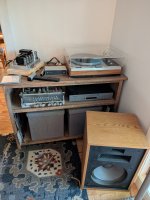
Old thread on this is closed and my situation is diff. I have a Pilot 505 Amp. Recently dug the tuner/preamp out of storage and found someone had recapped it. Plugged it in and it sounded great using my Andover Spin Stage as a phono preamp. Then discovered that two tubes were not heating up---the end tube in the preamp (the preamp uses a 12AX7 then a 12AU7, the AU socket was dead) and one of the sockets in the phonograph preamp portion. Note that I played this most of the afternoon with a friend and it sounded really good.
When I discovered that two sockets were dead, I found that the heaters for those sockets were powered by the 2nd power socket, which dummy me had not plugged in. Also turned out the tube that we thought produced the cleanest sound was dead. The unit had output, possibly due to how a feedback is wired, but working none-the-less. Perhaps, since the grid and cathode were in a live circuit, the unit sounded better with a dead tube in that position? Now, fully functional, the volume is higher (CDs have to be played in the 1st 1/8th of the volume knob) and the sound is rougher---I'd say more distortion. My turntable plays through the Pilot preamp now with some interesting tonal qualities but the good is overcome by the roughness.
My plan for now is to unplug the 2nd power umbilical and go back to how it was before I fixed it. Does that endanger any part of the unit?
,

If a tube heater isn't working make sure there is voltage at the socket. If there is voltage at the socket it could be that the tube is damaged. If a replacement tube also doesn't light it's probably because the tube pins aren't making good contact with the socket. Tighten the connections. On rare occasions you might find that the socket itself is defective and needs to be replaced.
All the tube heaters draw current. If some tubes aren't lighting the heater voltage will go higher. Higher heater voltage can reduce the life of the remaining tubes. This becomes more critical because when vintage gear was new wall voltages were lower. So heater voltages will be higher today even if everything is running properly. What heater voltage do you measure?
The pic of the guts that you posted in your thread on AK shows that someone previously replaced the original caps with orange drops. But it also seems to show that they didn’t change any of the old carbon comp resistors.
As I suggested over there, you should go through the preamp section and measure all the resistor values and replace them if necessary. Also check the voltages and compare them to what the schematic shows.
Unfortunately, the supplemental schematic that shows the phono preamp does not have voltages for each tube pin. It only shows that the supply voltage for that section should be 180v. Measure it and see what the supply voltage is. Then you need to go through the phono preamp and check all the resistor values there. If the resistor values are out of spec the tubes are not running as intended, even if the supply voltage is about right.
At least some of the resistors will probably be way out of spec. Old carbon comp resistors usually drift higher in value. This will change the operating points of the tubes and unit won’t sound right until everything is in spec. Old (brown) carbon comp resistors should be replaced with either carbon film or metal film types.
Usually a tolerance of 10% is considered to be OK. But even if they are still in tolerance they can be noisy. They will only drift more as time goes on so I usually replace any that are say 7% off. It’s not uncommon for me to find that 50% or more of the old resistors are out of spec. So I often replace them all just so I don’t have to go back in later.
When tubes are not used they aren’t drawing current, same as with the heaters. Or they might be drawing considerably less current than they should be if their resistors are way out of spec. With less current being drawn the voltages will go up elsewhere. When the voltages go up that also changes the operating point of the remaining tubes. Some parts could fail if they are exposed to voltages that are higher than normal.
So, it’s generally not a good idea to just leave some tubes disconnected. If you plan on using this, do it right, and restore it properly. If you’re not willing to put the effort in it’s best to pull it out of your system and use something else.
I’m confused by your comment about the preamp / tuner having two umbilicals. The schematic only seems to show one - a captive cord on the tuner chassis with a socket that on the other end that plugs into the amp. The version with the phono preamp seems to use a rectangular plug with 10 pins.
Maybe you could post a pic of the other umbilical and explain what it connects to on each end?
All the tube heaters draw current. If some tubes aren't lighting the heater voltage will go higher. Higher heater voltage can reduce the life of the remaining tubes. This becomes more critical because when vintage gear was new wall voltages were lower. So heater voltages will be higher today even if everything is running properly. What heater voltage do you measure?
The pic of the guts that you posted in your thread on AK shows that someone previously replaced the original caps with orange drops. But it also seems to show that they didn’t change any of the old carbon comp resistors.
As I suggested over there, you should go through the preamp section and measure all the resistor values and replace them if necessary. Also check the voltages and compare them to what the schematic shows.
Unfortunately, the supplemental schematic that shows the phono preamp does not have voltages for each tube pin. It only shows that the supply voltage for that section should be 180v. Measure it and see what the supply voltage is. Then you need to go through the phono preamp and check all the resistor values there. If the resistor values are out of spec the tubes are not running as intended, even if the supply voltage is about right.
At least some of the resistors will probably be way out of spec. Old carbon comp resistors usually drift higher in value. This will change the operating points of the tubes and unit won’t sound right until everything is in spec. Old (brown) carbon comp resistors should be replaced with either carbon film or metal film types.
Usually a tolerance of 10% is considered to be OK. But even if they are still in tolerance they can be noisy. They will only drift more as time goes on so I usually replace any that are say 7% off. It’s not uncommon for me to find that 50% or more of the old resistors are out of spec. So I often replace them all just so I don’t have to go back in later.
When tubes are not used they aren’t drawing current, same as with the heaters. Or they might be drawing considerably less current than they should be if their resistors are way out of spec. With less current being drawn the voltages will go up elsewhere. When the voltages go up that also changes the operating point of the remaining tubes. Some parts could fail if they are exposed to voltages that are higher than normal.
So, it’s generally not a good idea to just leave some tubes disconnected. If you plan on using this, do it right, and restore it properly. If you’re not willing to put the effort in it’s best to pull it out of your system and use something else.
I’m confused by your comment about the preamp / tuner having two umbilicals. The schematic only seems to show one - a captive cord on the tuner chassis with a socket that on the other end that plugs into the amp. The version with the phono preamp seems to use a rectangular plug with 10 pins.
Maybe you could post a pic of the other umbilical and explain what it connects to on each end?
First, part of my confusion has been with the console model number. That number probably refers to the wooden cabinet. I don’t think there were many real changes to components. They are either 500s or 505s. Did they ever put out a schematic other than mine?
The 505 power supply is shown on the alternate and hinted at on the amp schematic. Below is the 500 PS with a hint to the 505 PS. The 505 PS is shown on the alternate circuit. There is no rectangular plug. The umbilicals are hard wired in the preamp unit. The extra pwr plug is a 3 pin plug that connects to pins 11 & 12 on the preamp schematic. No real info on the 505 PS. The parts list just gives the PN.
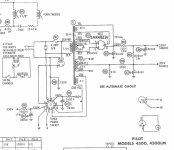
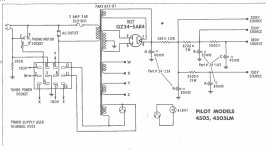
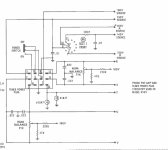
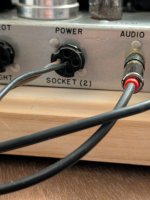
You are, of course, right. I should go through the preamp and make it right, it's a cool historical piece. I did check a few resisters when I had it open and they were well within 10%. I bought capacitors to put into this unit. But when I realized what was wrong, an embarrassing error, I put it back in service to see how it worked.
Your comment about this unit not being right for my system is spot on. And, I think, one reason is too much amplification. I tried replacing the 1st AF amp tube, the 12AX7, w a 12AU7. That improved the sound but CDs still have to play w the volume knob barely off 0. The TT needs the volume in the middle of the range. Going back to my Andover for phono preamplification, volume is close on both, still in lower end of the range.
I did really enjoy the all tube experience, but I'll have to go back to using the preamp portion of my NAD. I have started buying parts to build Bruce Heran's SRPP preamp but that's not a quick fix.
The 505 power supply is shown on the alternate and hinted at on the amp schematic. Below is the 500 PS with a hint to the 505 PS. The 505 PS is shown on the alternate circuit. There is no rectangular plug. The umbilicals are hard wired in the preamp unit. The extra pwr plug is a 3 pin plug that connects to pins 11 & 12 on the preamp schematic. No real info on the 505 PS. The parts list just gives the PN.




You are, of course, right. I should go through the preamp and make it right, it's a cool historical piece. I did check a few resisters when I had it open and they were well within 10%. I bought capacitors to put into this unit. But when I realized what was wrong, an embarrassing error, I put it back in service to see how it worked.
Your comment about this unit not being right for my system is spot on. And, I think, one reason is too much amplification. I tried replacing the 1st AF amp tube, the 12AX7, w a 12AU7. That improved the sound but CDs still have to play w the volume knob barely off 0. The TT needs the volume in the middle of the range. Going back to my Andover for phono preamplification, volume is close on both, still in lower end of the range.
I did really enjoy the all tube experience, but I'll have to go back to using the preamp portion of my NAD. I have started buying parts to build Bruce Heran's SRPP preamp but that's not a quick fix.
Too late to edit above post. Since the Pilot pre is still in place, I put the 12AX7 back, pulled the 12AU7 and, with the Andover, put on an S&G album and the sound is magical. Maybe I should try to build a modified clone of this.
The schematic indicates that the 500 and 505 use different power transformers. It shows the specs for the #55-77 used in the 500 but it doesn’t show details on the #55-87 used in the 505. You’ll need to measure the voltage on the 3 pin connector and trace where it goes. It looks like it powers a light bulb(s), possibly the dial lights on the tuner but it also shows a higher voltage. which is confusing. To me anyway.First, part of my confusion has been with the console model number. That number probably refers to the wooden cabinet. I don’t think there were many real changes to components. They are either 500s or 505s. Did they ever put out a schematic other than mine?
The 505 power supply is shown on the alternate and hinted at on the amp schematic. Below is the 500 PS with a hint to the 505 PS. The 505 PS is shown on the alternate circuit. There is no rectangular plug. The umbilicals are hard wired in the preamp unit. The extra pwr plug is a 3 pin plug that connects to pins 11 & 12 on the preamp schematic. No real info on the 505 PS. The parts list just gives the PN.
View attachment 1468465View attachment 1468468View attachment 1468470View attachment 1468472
You are, of course, right. I should go through the preamp and make it right, it's a cool historical piece. I did check a few resisters when I had it open and they were well within 10%. I bought capacitors to put into this unit. But when I realized what was wrong, an embarrassing error, I put it back in service to see how it worked.
Your comment about this unit not being right for my system is spot on. And, I think, one reason is too much amplification. I tried replacing the 1st AF amp tube, the 12AX7, w a 12AU7. That improved the sound but CDs still have to play w the volume knob barely off 0. The TT needs the volume in the middle of the range. Going back to my Andover for phono preamplification, volume is close on both, still in lower end of the range.
I did really enjoy the all tube experience, but I'll have to go back to using the preamp portion of my NAD. I have started buying parts to build Bruce Heran's SRPP preamp but that's not a quick fix.
Sams schematics sometimes do have errors. And according to the Sams index the schematic you have is the only one.
Your TT will need significant gain and, if the phono stage is working correctly, it should work OK. It might be a bit noisy with the old resistors though. You might want to use metal films there. The phono stage is the pair of 12AX7s that have shields. The single 12AX7 seems to drive the tone controls, though it probably also adds some gain and the 12AU7 on the output supplies some additional gain. I’m not into vinyl so I really don’t know much about phono stages.
It sounds like you’re using a separate (SS?) phono stage and running the output through one of the line level inputs of the Pilot. That would bypass the Pilot phono stage. The signal would then go through the single 12AX7 / tone control section but you seem to be bypassing the 12AU7 on the output. That may work but you should still measure voltages, especially the heater voltages and the voltages on the single 12AX7.
You probably don’t need much, if any, gain for a source with line level output. If you have something with a variable output, like a DAC or streamer, try connecting that directly to the amp. I’ve been using a cheap ($25) DAC on the bench. It has remote control volume, optical and coax inputs for my CD player and Bluetooth for streaming. I’ve got more expensive ones too as well as a Wiim Pro Plus streamer, all of which have variable outputs.
I’m not familiar with the preamp you mention but most line stages seem to have way too much gain. Check the tube data sheet for the amplification factor (mu) of the tubes used. Unless you have a weak source (some phones for example) anything over a mu of 10 will likely give you the same issue that you already have. The 12AU7 on the output of the Pilot has a mu of 20, for example. Though actual gain will be lower than mu, the mu is useful for comparing different tubes.
I recently built a preamp that has very low gain (tube has a mu of ~8) as well as output impedance that’s under 1k, so it can be used with both SS / Class D and tube amps. Very simple and cost less than $100 to build. Details are here, if you’re interested:
https://audiokarma.org/forums/index.php?threads/the-flow-pre4d-a-diy-tube-preamp.1084409/